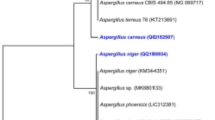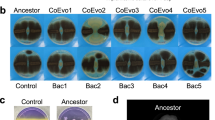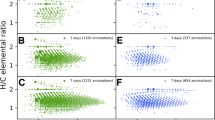Abstract
THE production of ‘biochemical ‘mutants of fungi by means of ultra-violet or X-radiation has been reported by Beadle and Tatum1,2 (Neurospora spp.), Fries3,4,5,6 (Ophiostoma spp.) and Pontecorvo7 (Aspergillus and Penicillium spp.). Following the use of mustard-gas (β,β'-dichlorodiethyl sulphide) in producing mutations in the vinegar fly (Drosophila melanogaster) by Auerbach and Robson8, this reagent has been used by Horowitz et al.9 to produce mutations in Neurospora spp. A method for isolating strains of Aspergillus nidulans deficient for a specific amino-acid, cystine, from a mixture of mutants produced by mustard-gas, is now described. These special mutants grow normally in presence of cystine but are unable to grow with sulphate as sole sulphur source.
This is a preview of subscription content, access via your institution
Access options
Subscribe to this journal
Receive 51 print issues and online access
$199.00 per year
only $3.90 per issue
Buy this article
- Purchase on SpringerLink
- Instant access to full article PDF
Prices may be subject to local taxes which are calculated during checkout
Similar content being viewed by others
References
Beadle, G. W., and Tatum, E. L., Proc. U.S. Nat. Acad. Sci., 27, 499 (1941).
Tatum, E. L., and Beadle, G. W., Proc. U.S. Nat. Acad. Sci., 28, 234 (1942).
Fries, N., Svensk. Bot. Tidskr., 39, 270 (1945).
Fries, N., Svensk. Bot. Tidskr., 40, 127 (1946).
Fries, N., Nature, 158, 757 (1946).
Fries, N., Arkiv för Botanik (Uppsala), 33, 1 (1946).
Pontecorvo, G., Cold Spring Harbor Symposia on Quantitative Biology, 11, 193 (1946) and personal communication.
Auerbach, C., and Robson, J. M., Nature, 157, 302 (1946).
Horowitz, N. H., Houlahan, M. B., Hungate, M. G., and Wright, B., Science, 104, 233 (1946).
Fries, N., Nature, 159, 199 (1947).
Author information
Authors and Affiliations
Rights and permissions
About this article
Cite this article
HOCKENHULL, D. Mustard-gas Mutation in Aspergillus nidulans. Nature 161, 100 (1948). https://doi.org/10.1038/161100a0
Issue date:
DOI: https://doi.org/10.1038/161100a0



